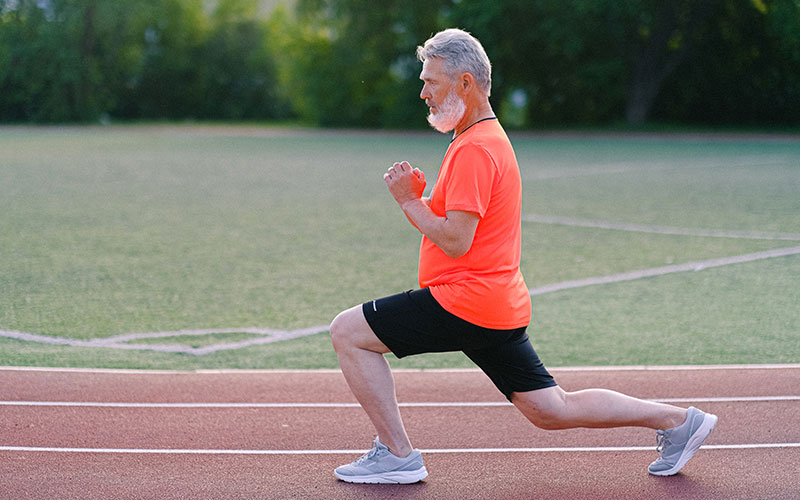Personal Trainer
Introduction
To warm-up or not to warm-up? That is always the question but why do we even ask it to begin with? We know we should warm up before a workout or any strenuous activity, so why do we tend to ponder whether to complete a warm-up or stretch, or just skip it all together? The intention of this article is to make this decision easier for you by explaining the benefits of warming up, specifically dynamic warm-ups, and providing a quick and effective dynamic warm-up you can use before your workouts.
Benefits of a Dynamic Warm-Up

To clarify, think of “dynamic” as “moving”. Therefore, anything dynamic in a warm-up has to do with moving your body; Unlike stretching, where you hold a position for a duration of time. The purpose of a dynamic warm-up is to stimulate a physiological change in the body to prepare for exercise, which can take place in a variety of forms:
Increase in Heart Rate and Blood Pressure
Warming up increases heart rate and blood pressure and allows for more oxygen to be transported quickly to the muscles.
Increase in Neuromuscular Activity
Increased neuromuscular activity enables the mind-body connection to occur, which essentially equates to faster reflexes. Reflexes allow your body to react in ways that help you lead a safer and healthier life.
Increase in Respiration Rate
When you perform a warm-up, your respiration rate increases, meaning we breathe at a faster rate, therefore, intaking more oxygen to feed our muscles.
Increase in Body Temperature and Muscle Elasticity
Performing a dynamic warm-up triggers a rise in our body temperature, and literally warms up the body, hence the name. As well, our muscles and tendons loosen to increase range of motion and decrease stiffness. This promotes a more efficient use of our joints and muscles.
Dynamic Vs. Static Warm-Up

From the research article, Acute Effects of Dynamic Stretching, Static Stretching, and Light Aerobic Activity on Muscular Performance in Women, “The role of a warm-up is to prime the body’s cardiovascular, muscular and neural systems to meet the demands of a specific activity.” (Curry et al., 2009) More simply put, a dynamic warm-up is used to prepare the muscles and joints before a workout, leading to increased performance and injury prevention, while increasing range of motion in the joints.
Women with the following conditions or pregnancy complications should not exercise during pregnancy unless they receive specific instruction and clearance from their healthcare provider:
Dynamic Warm-Up: How To
Some examples of great dynamic warm-up movements are as follows:
1. Hip rock-backs
This movement opens the hips for easier hip rotation as well as adduction and abduction. This, in turn, reduces the risk of groin injury.
2. Quadruped rotations
Quadruped rotations are performed in what is known as the tabletop position. With your knees and palms on the floor, flat back, while your joints are stacked, proceed by “threading” your right arm under your left until your right shoulder touches the floor. Then, twist upward reaching to the sky. Make sure you complete this for both sides of your body.
3. Downward dog to cobra
This dynamic movement is great for hamstring, hip flexor, and spine health. In a downward dog position, you are basically folding your body forwards while planting your palms and feet on the ground. Holding a flat back with your behind being raised to the sky. To move from downward dog to cobra pose, begin by lying down on your stomach with your legs stretched out behind, with the tops of your feet on the ground.
4. Inchworm lunge sequence
This is a full body exercise and by this point in the warm-up, your body should be feeling warm to the touch. This will surely raise your heart rate. Inch-worms start from a standing position, bend over to touch your toes and walk your hands forward until in a high plank or push up position. At this point, bring your right leg up by your right hand and raise your left hand up to the sky and switch sides. Walk hands back to the starting position and stand straight up. That is 1 rep.
Conclusion
Aim to perform each of these movements for at least 5 reps to ensure the muscles are being activated. A good tip to know your body is prepared for physical activity is if you feel warm and possibly have some sweat building up. The warm-up is not a workout and should leave you with energy for your workout after. If you feel too drained for your workout afterwards, you did not do a proper warm-up and may have took it too far. Remember, the point is to prevent injury and enhance performance. So stay safe and keep sweating.
Begin Your Journey with Us
If you’re finding it challenging to get started on your journey, feel free to reach out to us for a complimentary consultation. We would be more than happy to offer some guidance to help you move forward. Sometimes taking the first step is the hardest, so don’t hesitate to get some help to kickstart the process. We all start somewhere.

